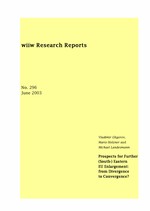Prospects for Further (South-) Eastern EU Enlargement: from Divergence to Convergence?
Vladimir Gligorov, Mario Holzner and Michael Landesmann
wiiw Research Report No. 296, June 2003
This paper looks at the experience of South East Europe which -- for the purposes of this paper -- includes the former states of Yugoslavia except for Slovenia (i.e. Croatia, Serbia-Montenegro, Bosnia-Herzegovina, and Macedonia), Albania, and the two EU candidate countries, Bulgaria and Romania. For all these economies, accession to the EU will be the overriding driving force of the policy-making agenda for the foreseeable future, albeit with widely different time horizons in the individual economies. In Part One we describe the South East European (SEE) 'region' as one which has over the 1990s significantly 'fallen behind' in the process of economic development relative to the group of Central and Eastern European (CEE) economies which will join the EU in 2004. While developments are somewhat heterogeneous, there is, in particular, an abysmal employment record which has not even started to turn around, as well as an extremely bad productivity and export performance. In Part Two, we discuss in greater detail the conditions required to move towards a sustained growth and catching-up process. We analyse the problematic states of transition in some of the SEE economies as well as the basic disequilibria (fiscal, external, labour markets) which need to be resolved for sustained development to take place. The prospects of making up for the lost decade and dealing with the unresolved disequilibria will be a crucial issue in evaluating the prospects of EU accession some time in the future. We discuss the stumbling blocks both from the SEE side and the EU side in developing a clear perspective of integration with the EU.
Keywords: South East Europe, Balkan economies, convergence, EU enlargement
JEL classification: P51, P52, O11, O11, O57, O4
Research Areas: Macroeconomic Analysis and Policy, Regional Development
